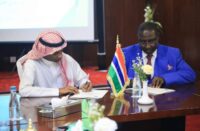 Assume you’re the Governor of Central Bank of The Gambia, what Monetary policy/ies would you adopt? What goals will you be trying to achieve with your choice?
Assume you’re the Governor of Central Bank of The Gambia, what Monetary policy/ies would you adopt? What goals will you be trying to achieve with your choice?
Assume you’re the Finance and Economic Affairs Minister, what fiscal economic policy/ies would you adopt? How would the Appropriation Bill reflect your adopted policy/ies?
What should Dr. Barrow administration do?
These are no hypothetical questions for our country. These are questions facing our nation and the government is apparently unable to answer. Politicians across the board did not come up with any viable answer either. Nor do activists provide answers that bear on the facts. The best I have seen/heard so far “… oh! yeah! Government has to take loans because even USA and China take loans to develop their economy…”
The Gambia is neither USA nor China in very financial/economic significant ways. Therefore, because USA/China borrowed is no good reason for the Governor and/or Finance Minister of The Gambia proposed the Gambia to borrow.
The Gambia is already 53 years old. We’re already in business for all these years. Any discussion of debt should account for CURRENT NATIONAL BALANCE SHEET – ASSETS vs LIABILITIES. The current liabilities are legal and economic obligations to be paid when due. Our ability to pay should dictate what we should and/or should not borrow and not because all nations including USA and China are borrowing. THE TOTAL LIABILITIES D56.4B WITH 2018 DUE OF D4B – SEE TABULATION.
Place yourself at the desk of a policy-maker such as Governor/Finance Minister responsible to our nation for these decisions. Your best response will be informed by the facts of The Gambia and not what other countries do or not do.
Now let’s examine the Gambia’s basic financial outlay. The tabulation shows the last and first years in office of our 3 presidents. We will focus on Fiscal matters that affect our economic well-being. This budget layout is not the tool used by the Central Bank Governor to formulate monetary policy. Although this and other economic indicators will inform him/her choice for 1st basic decision – expansionary or contractionary economy. Anyway monetary policy matters another day!
We going for numbers for 2018 (Dr. Barrow’s 1st full year budget)
Comparison of 2017, Revised 2017 & 2018 Appropriation Bills (Budgets) in D/billions
Descriptions
1994 – Jawara’s Last
2017 – Yahya Last
Revised 2017 – Barrow First
2018 – 1st full yr Barrow
REVENUE
- Taxes
0.6
7.86
8.5
– Non-Taxes
0.08
0.674
0.9
GRANTS
0.09
5.8
0.782
10.2
TOTAL REVENUES
0.77
14.334
12.242
10
COSTS
Govt.-personnel
0.49
2.68
2.68
Govt.-recurring costs
0.62
2.8
19.1
Debt Interest Servicing
0.13
3.7 (2016 figure)
2.768
4
Remainder of revenue
-0.646
SUB TOTAL CASH
5.154
TOTAL EXPENDITURE
0.85
19.1
13.198
20.09
DEFICIT
– 0.08
– 4.766
– 0.995
– 0.9
NATIONAL DEBT/GDP by 2016 120%
GMD56.4b
What’s The GDP? @ GMD47/US$
GMD47b
National Revenue: D9.4b. This is a projected number – we may collect that much/we may not. Historically we don’t. That’s why IMF/World Bank are always propping up with the famous ‘budgetary support’ to be able to pay wages. National revenue is the money the Gambia expect to receive on taxes, fees, royalties, dividends from SOEs, etc. in the year 2018. So, it is only from this we can pay our expenses (bills). Take note of that! Any expenses more than that will be like YOU want to spend more than your wage.
Grants: D10.2b. This number has several problems. Government is accounting it for budgetary purposes as cash revenue coming in and that’s not the case. All or most of these are coming as projects. A good example of that is the building of The Friendship Hostel and Independent Stadium, Gambia German Forestry Project, etc. These are worth billions of Dollars/Dalasis but not delivered as cash to government. In fact, for many such projects the donor nation sends along expatriates who control the implementation. It’s deceptive accounting at best and/or knowingly lying by accounting expected project funds as revenue in order to reduce the actual budget deficit. The 2nd issue which I can’t proof but worth a mention, is that compared to last year or even several years back the projected grant figure of D10.2 appeared inflated. We can proof these if they produce Variance Reports that shows the projected vs actuals. Whatever proportion of the projected grants are not cash receipt will only increase the above budget imbalance – hence the deficit.
Costs of government (paying wages, rents, ink, pens/pencils, telephones, vehicles, fuel, repairs, etc.: D19.1b. Noticed that this is ONLY OVERHEAD COST. This is the cost of having that government. This is not the roads, paracetamols, water, electricity, etc. that we paid taxes for in the first place. Even if you leave the D10.2 grant estimation as cash the costs of government is larger than the National Revenue. SIMPLY THE COLLECTOR COSTS MORE THAN COLLECTED. Each policy maker should tell us if that should be the case or not. More importantly the new government should be able to tell us how to revise the situation. Instead the made it worth – see the numbers between Yahya’s last and Barrow’s first budget estimates.
Debt Interest servicing: 2018 debt interest to be paid back is estimated at D4b. This is a legal obligation to be paid unless written-off by our creditor(s). Noticed that government cost has consumed all our money. Where then can we pay this D4b? To understand the implication of this problem we should know certain facts: We know there is no money left because of wages and other recurring costs. We know the debts were legally contracted and must be paid come due. We know if we fail to pay our credit, our worthiness rating will drop making future loans prohibitively expensive – that will compound our poverty. We also know our debt structure is 3:2 – 60% domestic and 40% international. That means 60% of our debt is borrowed from within. The implication of high domestic borrowing means that portion is unlikely to be written-off. X or Y that purchased D10K or 100K treasury bills from Central bank is not well-off to forgive the country. If you’re one of those asking Dr. Barrow to ask for debt-forgiveness – here’re one limitation to that challenge. Because of the high borrowing cost (18-25%) in The Gambia continual domestic borrowing is grinding the nation into deeper poverty. Furthermore, defaulting on domestic debt means strangulating or killing the golden goose – the very productive base that fuel our economy. Last on debt serving, paying D4 out of D9.4b National Revenue is 43% of the National Revenue. Already the costs of government have consumed our revenue. What do we do? Or what are they doing to keep us afloat – IMF/World Bank. That’s it own topic we can discuss another day.
Program costs: Dr. Barrow’s Appropriation Bill 2018 did not publicly provide clear sector costings. Yahya’s budgets show the program allocations by sector. If and when I do, I will be more than happy to factor those costs into the analysis. Regardless whatever is estimated for PROGRAMS WILL HAVE TO BE DEFICT FINANCE SINCE OUR REVENUE IS LESS THAN COSTS OF GOVERNMENT AND AS WELL DEBT INTEREST SERVICING. This why when they tell you there will be an uninterrupted electricity by December 2017 (already gone by 5 months ago) it will not happen. There is no money and the money to build Gambia did not/is not/will not come from the pockets of Jawara, Yahya and now Barrow. So far though all 3 failed abysmally to be good stewards of tax revenue.
Budget deficit: D0.9b. This is a doubtful number. The true deficit number will run into billions of dalsis if and when we removed all deceptive accounting entries and established exactly how much government intends to spend on programs.
National Debt: Government is not give a hard figure on the amount of debt except it’s total at 120% of GDP. Our GDP is estimated at over US$900m. For simplicity I rounded that up to US$1b. At an exchange rate of US$1 = GMD47 our national debt will be about GMD56.4b. See the last 2 rows of the tabulation. That means our per capita debt is D28,200. Now think for a moment – is it possible for each of the 2 million people to produce D28,200.00 to pay off this debt? The answer is no. Many are kids (not at productive age), some are sick/ill and cannot produce, others are over ages/retired and are not producers. So, there is only a small productive base that has to produce to pay-off this loan. The smaller that productive base the bleak the prospects for the equation to balance.
KNOWING THESE FACTS HELP US MAKE INFORM DECISIONS AS TO WHETHER CONTRACTING LOANS ARE GOOD OR BAD. THIS HAS NOTHING TO DO WITH WHETHER USA OR CHINA ARE CONTRACTING LOANS. IT IS NEVER GOOD FOR US, WHO SUPPOSEDLY KNOW AND SHOULD TRY TO SHAPE DISCUSSION ABOUT OUR NATION BE THROWING OUT GENERALIZED STATEMENTS……SUCH AS EVEN USA IS CONTRACTING LOANS. WHAT HAS THAT TO DO WE GAMBIA’S BALANCE SHEET AND INCOME STATEMENT. IT DOESN’T HELP OUR NATION.
USA Total Revenue $3.4 trillion
USA GDP $18.57 trillion
USA National debt over $21 trillion
Very bad too. Because of bad government. USA government is as fiscally irresponsible as Gambia government. Because is USA doesn’t mean is good. Fortunately for USA, there money is world’s money so they have the luxury to print as much and pay whoever. Gambia maybe able to print as much they can afford but can pay anyone outside our borders. USA won’t probably do that because of other institutional restraints in place. They can also inflate the dollar for payment purposes – meaning they will give out less on current obligation. Again, they are not likely to do that for the same reasons.
God Bless Gambia
To The Gambia Ever True
Burama Jammeh
Ends


